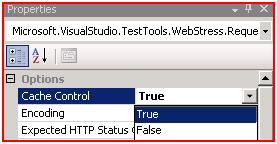How to simulate IE Caching in VSTS 2008
Sometimes it’s beneficial to run load test simulating IE cache. For example, if application is used frequently by repeated users, or if project team wants to set up production monitoring system that measures user experience with cache.
There are two places in VSTS where cache should be enabled to achieve close IE cache simulation:
1) In the web test, “Cache Control” property should be set to True for every single request (see Note below for the code example):
2) In the load test properties, “Percentage of New Users” property should be set to 0:
Note: Setting cache control property to true for every single web request manually would be feasible if web test had only a few requests. But when the amount of requests grows to hundreds or more, it’s beneficial to use the code below, kindly provided to us by Sean Lumley, Senior SDE from VSTS team. You would have to convert your web test to coded C# test to use this code:
public class WebTest1Coded : WebTest
{
public WebTest1Coded()
{
this.PreAuthenticate = true;
this.PreRequest += newEventHandler<PreRequestEventArgs>(WebTest1Coded_PreRequest);
}
void WebTest1Coded_PreRequest(object sender, PreRequestEventArgs e)
{
e.Request.Cache = true;
}
public override IEnumerator<WebTestRequest> GetRequestEnumerator()
{
WebTestRequest request1 = new WebTestRequest("https://localhost/");
request1.Encoding = System.Text.Encoding.GetEncoding("utf-8");
yield return request1;
request1 = null;
WebTestRequest request2 = new WebTestRequest("https://localhost/");
request2.Encoding = System.Text.Encoding.GetEncoding("utf-8");
yield return request2;
request2 = null;
}
Parts of the code, which are in bold, are the only parts you would have to add to your coded web test. After applying this code, all your requests will have Cache Control property set to True.
Here is the table with results from 5 short load test runs, where we modified Cache Control property in the web test and/or Percentage of New Users in load test property:
|
1st run |
2nd run |
3d run |
4th run |
5th run |
Cache control property |
False |
False |
True (manual) |
True (manual) |
True (Coded) |
% of new users |
100% |
0% |
100% |
0% |
0% |
tests |
12 |
12 |
12 |
12 |
12 |
total requests |
2400 |
1918 |
1660 |
1177 |
1181 |
requests/sec |
27 |
23.3 |
24.9 |
20.2 |
19.8 |
cached requests |
1560 |
2231 |
2532 |
3225 |
3225 |
duration |
88 sec |
82 sec |
66 sec |
58 sec |
59 sec |
As you can see from the table above, combining those two cache settings gives us the most caching (cached requests in the table). Also, code example provided above, generates the same amount of caching as manual process would do. (Compare run#4 and run#5 results).
Another observation we noticed was related to actual cached user page load times. Enabling both caching properties in VSTS provided transaction times, which were very close to actual end user cached experience (no more than 1 sec difference on 5-10 sec transactions). Those numbers were close for our application, but this might not be true for every application. That’s why you should verify close matching of those numbers for your particular application.
----------------------------------------
Vitaliy Konev
Performance Engineer
Microsoft – ACE Team
Comments
- Anonymous
September 26, 2008
PingBack from http://hoursfunnywallpaper.cn/?p=8090 - Anonymous
September 26, 2008
Great tip!Thanks for sharing - Anonymous
September 28, 2008
Over on the "ACE Team" blog there's a useful blog post with some performance tips for ASP.NET - Anonymous
September 29, 2008
196 Microsoft Team blogs searched, 97 blogs have new articles in the past 7 days. 218 new articles found...

